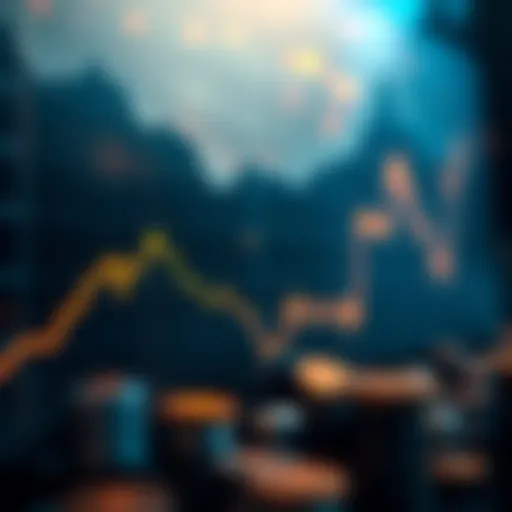Exploring the Highest Valued NFT Art Sales
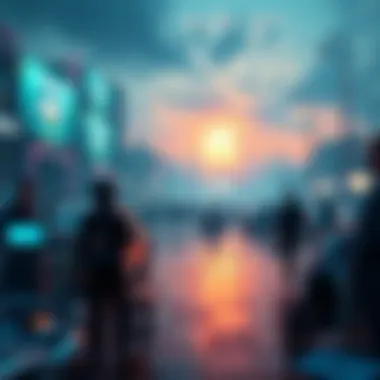

Intro
The rise of NFT art has transformed how we perceive and value creativity in the digital realm. Non-Fungible Tokens, or NFTs, are unique digital assets that signify ownership of specific items, often represented as art, music, or even tweets. Unlike traditional art markets, where provenance and authenticity can be murky, NFTs provide a clear, verifiable digital certificate—and with it, a new means for artists to showcase their work.
Caught in the whirlwind, NFT art has become a hot topic of discussion, especially as prices for certain pieces have skyrocketed. The biggest sales seem to defy expectations, raising questions not only about the future of art but also about our relationship with digital ownership. It begs the inquiry: what makes these pieces fetch such staggering sums?
This article delves into that intricate web, exploring the most expensive NFTs sold to date while examining the factors behind their valuation. By unpacking these details, we can begin to understand the broader implications of this burgeoning market.
Market Trends
Current Market Analysis
As of now, the NFT market has stabilized some after its explosive growth. Recent figures from platforms like OpenSea highlight that sales remain strong, albeit less frenzied than the peak moments of 2021. The total sales volume frequently shifts, yet certain segments of high-end NFT art maintain remarkable resilience. The trend seems to point towards a more refined focus on quality, rather than sheer quantity.
Several artists have emerged as leaders in this space, commanding prices that rival those of their traditional counterparts. For example, pieces by Beeple have sold for millions, emphasizing not just the value of the work itself, but the artist's reputation and connection to the collector community.
"Investors arguably see NFTs as a new vein for wealth creation, where the intersection of technology and art allows new avante-garde expression."
Historical Trends and Patterns
To grasp where the NFT market is heading, we must take a step back and examine its history. The initial boom in awareness started back in 2017, with CryptoKitties leading the pack. Fast forward to 2021, and the market was ablaze with enthusiasm after multiple records were broken in rapid succession. Pieces that sold for mere thousands were swiftly turning into multi-million-dollar sales.
Some trends noted over the years include:
- Celebrity Influence: High-profile celebrities entering the NFT space have helped to drive prices up. Their endorsement often leads to heightened interest and investment.
- Diverse Offerings: The market now spans beyond visual art, including music, and even virtual real estate in the metaverse.
- Community Building: Creators are emphasizing community engagement through platforms that allow for ongoing interaction between artists and collectors.
An observable pattern reveals that even during dips in the market, select NFTs consistently maintain a certain cachet that attracts collectors.
Investment Strategies
Investing in NFT art requires a keen understanding of both the art itself and the greater landscape of digital assets.
Long-Term vs Short-Term Investments
Investors often grapple with the blueprint of their investment strategies. Long-term investors tend to focus on the established artists whose works hold intrinsic value. They consider their prospects, understanding that digital art could capture greater appreciation over time.
In contrast, short-term investors may chase the latest trends, looking for quick profits on new drops. However, this approach carries a risk, as saturation in the market can lead to stark fluctuations in values.
Risk Management Techniques
Given the volatility associated with NFTs, adopting sound risk management techniques is paramount. Some strategies to consider include:
- Diversification: Spreading investments across various forms of assets can help mitigate losses.
- Research: Staying informed about artists and market trends can provide insights into potential future value.
- Community Engagement: Participation in forums or social media groups can offer valuable perspectives and alert investors to shifting trends.
While entering this vibrant yet unpredictable market, investors need to strike a balance between passion for art and sharp market acumen.
As the world of NFTs continues to evolve, understanding these trends, alongside effective investment strategies, can support a thoughtful approach in navigating the intricate mosaic of digital art.
Understanding NFT Art
The rapidly growing realm of NFT art is reshaping how we perceive art ownership, creation, and exchange. With traditional boundaries being pushed aside, understanding NFT art is crucial not just for artists, but also for investors and collectors alike. This section provides a foundational overview that connects the dots between technology, artistry, and market trends, paving the way for deeper exploration in subsequent sections.
Defining Non-Fungible Tokens
At the core of NFT art is the concept of non-fungible tokens. Simply put, these are digital assets that represent ownership of unique items or pieces of content. Unlike cryptocurrencies such as Bitcoin or Ethereum, which are interchangeable with one another, NFTs are distinctly unique. This uniqueness is enabled through blockchain technology, primarily on platforms like Ethereum. With NFTs, every transaction and ownership detail is securely recorded in a decentralized ledger, ensuring authenticity and provenance.
"NFTs provide a new level of security and verification that art has craved for a long time.”
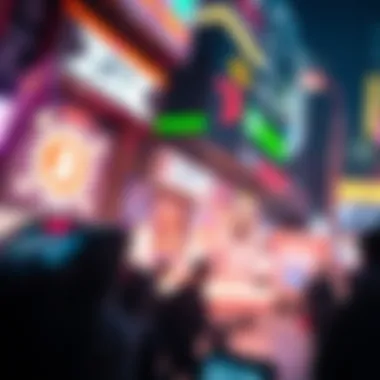

This ability to certify originality transforms the art landscape. In a world where digital art can often be easily replicated, owning a true NFT guarantees that the holder has something genuinely one-of-a-kind, akin to having an original painting hanging in a gallery.
The Evolution of Digital Art
Digital art isn't a new concept; it has been around for decades. However, the recent surge in popularity surrounding NFTs has breathed new life into the digital art world. Artists who were once battling perceptions of illegitimacy now find themselves on center stage.
With the rise of technology, various forms of digital art emerged, from graphic design to animations, but they lacked the critical metric of ownership. As NFTs gained traction, artists began minting their works into non-fungible tokens, successfully turning pixels into profit. The ability to tokenize their art not only gives them a financial stake in their work but also allows for residual income from future sales due to smart contract functionality, a feat unheard of in traditional art markets.
Significance of Ownership in the Digital Realm
Ownership in the digital space has long been a contentious issue. The internet's open nature often leads to widespread duplication and sharing, making it difficult for creators to monetize their work. However, NFTs disrupt this cycle by attaching ownership rights directly to a digital piece.
Participants in the NFT market engage in a new form of collecting, one that melds traditional art collecting with modern technologies. Collectors purchase NFTs not just for the art itself but for the prestige that comes with ownership. This newfound significance of ownership extends far beyond the art piece; it is a statement about status, investment, and cultural relevance.
In summary, understanding these facets of NFT art sets the stage for exploring more complex themes in this article. The transformation from mere digital files to coveted ownable assets represents a pivotal shift within both the art and investment landscapes.
Recording the Most Expensive NFT Sales
In the ever-changing landscape of digital art, tracking the most expensive NFT sales sheds light on their value and the underlying factors driving prices. This segment of the article takes a closer look at some of the notable transactions that have attracted the world's attention and set benchmarks for future sales. By understanding these key moments, one can grasp not just monetary value but also cultural significance, artistic innovation, and the evolving role of technology in art.
Analyzing these monumental sales helps collectors, investors, and art enthusiasts pinpoint trends, making it a vital aspect of comprehending the broader implications of NFTs in the art market. These sales serve as signposts in the economic narrative of digital art, reflecting the enthusiastic merging of art and technology.
Beeple's 'Everydays: The First Days'
Perhaps the most sensational splash in the NFT world was Beeple's 'Everydays: The First 5000 Days', sold for an eye-popping $69 million at a Christie's auction in March 2021. This digital collage was nothing short of a revolutionary moment, not only due to its staggering price tag but also for its representation of a new age in art collection.
Beeple, whose real name is Mike Winkelmann, has been creating digital art daily since 2007, consistently pushing boundaries. His work encapsulates social commentary, memes, and pop culture in a unique style that resonates with both tech-savvy audiences and traditional art lovers. This particular piece represents years of growth, development, and a commitment to the art form. The price reflects not only the artwork's ambition but also a desire for authenticity in digital ownership.
"Sold at auction, 'Everydays' highlights the intersection of art and technology, signaling a paradigm shift in the art world."
CryptoPunk
Another lion’s share of the NFT conversation revolves around CryptoPunk 7804, which fetched around $7.6 million. CryptoPunks, created by Larva Labs in 2017, are algorithmically generated pixel art characters and hold a prestigious spot in the NFT history as one of the first blockchain art projects.
The uniqueness of CryptoPunk 7804 shines through its characteristics— it’s one of the rarest punks due to its traits, including a cowboy hat, a pipe, and a blue skin tone. The rarity amplifies its allure, but it’s the cultural status that marks its significance. The CryptoPunks series revitalized interest in digital collectibles and has become iconic in various circles, from art aficionados to crypto investors seeking status symbols.
Crossroads by Beeple
In another significant example, Crossroads by Beeple sold for a staggering $6.6 million at auction shortly after the U.S. presidential election in 2020. This piece reflects political commentary and cleverly taps into the zeitgeist, illustrating how the NFT medium can provide not just art but powerful narratives.
The interactive nature of this artwork— which changes based on the outcome of the election—adds an extra layer to its significance. It is not only a static image; it morphs to present different outcomes, creating a dialogue about the contemporary political landscape while also showcasing the creative potential of NFTs.
To sum up, these sales construct a narrative of the rapid evolution of the art market, revealing the interplay of technology, cultural commentary, and market dynamics. Recognizing these developments doesn’t just enrich the understanding of NFTs but also brings forth a deeper appreciation for the artists pushing the envelope in this new realm.
Factors Influencing NFT Prices
Understanding what influences NFT prices can provide invaluable insights for potential investors and collectors. The price of each digital piece is shaped not just by the artwork's aesthetics but also by various elements that can significantly affect value in this volatile market. For collectors and investors, this understanding is crucial for making informed decisions.
Demand and Scarcity
In the world of NFTs, demand and scarcity are the twin pillars that often dictate market prices. Imagine walking into a gallery only to find that one artwork is the sole piece by an upcoming artist gaining massive traction online. It certainly adds to the allure, doesn’t it? When an NFT is perceived as rare, its value inevitably climbs.
- Limited Editions: Many artists release a set number of NFTs, which creates a sense of urgency among buyers. The fewer there are, the more desirous they become. For example, if an artist releases 100 copies of a work, the ratio of supply to collectors is significantly reduced. This often leads to a bidding war, driving up the price exponentially.
- Market Buzz: Speculation plays a massive role. If an artist’s social media presence spikes due to their previous success, interest in their upcoming NFT can reach fever pitch.
The heart of this dynamic can be summarized in a simple quote: > “An item is only worth what someone is willing to pay for it.” In the realm of NFTs, this quote rings even truer.
Artist Reputation and Market Placement
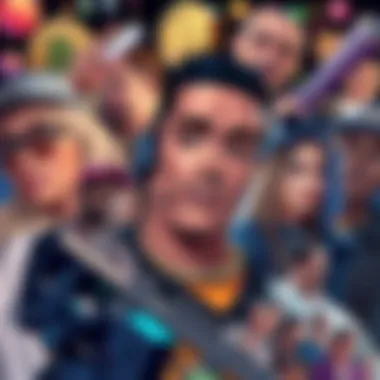

The reputation of the artist significantly plays into the price an NFT might fetch at auction. Established artists with a history of successful works often experience a different marketplace compared to emerging artists.
- Proven Track Record: Artists like Beeple are household names in the NFT space. A strong track record translates to higher bids during auctions. Their previous sell-outs create a beneficial cycle; buyers are likely to invest, knowing their past works were valuable.
- Current Market Trends: Where an artist's works are placed on the market can decide whether their NFTs fly off the virtual shelves or gather digital dust. High-profile auctions like those held by Christie's and Sotheby’s attract collectors with deeper pockets, often leading to higher sale prices.
Moreover, brands collaborating with artists can affect perceptions of worth. For instance, a partnership with a well-known clothing brand could elevate an artist's status, consequently boosting the value of their NFTs.
Cultural Significance and Trends
Cultural relevance, amidst all the technological wizardry, can arguably be one of the strongest factors influencing NFT prices. Artwork that resonates with societal problems, movements, or significant events tends to see an uptick in demand.
- Timeliness: If an NFT art piece speaks to a current issue, say climate change or political unrest, collectors may feel a sense of urgency to own a piece that showcases their values or beliefs.
- Community Engagement: Participation and engagement in subcultures can create a
Artist Perspectives in the NFT Marketplace
Understanding the views and experiences of artists in the NFT marketplace is crucial for grasping how this digital art form has evolved. Artists, often called digital artisans or creators, operate in a unique space where traditional art principles clash and merge with technological innovations. This interaction shapes both their work and their livelihoods. From embracing new technologies to grappling with new challenges, their stories provide valuable insights.
The Role of Digital Artisans
Digital artisans are the heartbeat of the NFT ecosystem. They are not just mere creators but visionaries who harness technology to expand their artistic expressions. The emergence of NFTs democratizes art by allowing artists to reach global audiences without the gatekeeping often present in traditional art markets.
Benefits of NFTs for Artists
- Direct Sales: Artists can sell their work directly to collectors, eliminating the need for intermediaries like galleries.
- Royalties: Many NFT platforms offer smart contracts that allow artists royalties from secondary sales, providing ongoing revenue streams.
- Wider Reach: The digital nature of NFTs enables artists to showcase their work globally, transcending geographical boundaries.
The heightening visibility can result in broader sales and higher prices. However, this also requires artists to grasp not just the art-making process but the mechanics of blockchain technology, market trends, and digital marketing.
"Creating art in the NFT space is like painting on a canvas that belongs to the whole world, and everyone can see it, which is both thrilling and daunting."
— Anonymous Digital Artist
Challenges Faced by Creators
While the potential rewards are considerable, the NFT landscape is equally fraught with challenges. Artists face several hurdles that can complicate their journey through this new marketplace.
- Over Saturation: With a surge of artists entering the NFT realm, standing out amidst a sea of digital art becomes increasingly hard.
- Market Volatility: The NFT market is notoriously fickle, where prices can fluctuate drastically overnight, leading to financial uncertainty.
- Technical Barriers: Not all artists are tech-savvy. Many struggle with the intricacies of platforms, wallets, and blockchain integration, creating a significant entry barrier for some.
- Intellectual Property Concerns: As NFTs are linked to ownership records on the blockchain, questions over copyright infringement arise. Artists must navigate the murky waters of protecting their creations while dealing with potential plagiarism.
Artists in the NFT space find themselves at a crossroads, balancing their creative motivations with the realities of a fast-paced, often unpredictable market. Those who succeed rifle through the challenge, learning and adapting in ways that could only be imagined just a few years ago.
These perspectives highlight not only the innovative potential but also the complex challenges artists face in the NFT marketplace, setting the stage for deeper discussions on investment trends, collector behavior, and ethical considerations in the sections to follow.
Collector Behavior and Investment Trends
The realm of NFT art is not just a new playground for artists but also a significant shift in how collectors approach investment in artworks. Understanding collector behavior and the strategies they employ is crucial in comprehending the broader implications of NFT sales. As the market evolves, the motivations behind purchases, the role of social media, and the psychological aspects of collectors become more prominent in relation to value and investment potential.
Understanding the Collector Mindset
Collecting has always been more than just about ownership. When it comes to NFT art, collectors often carry a unique blend of motivations that can diverge quite sharply from traditional collectors of physical art.
- Status and Exclusivity: Many collectors are driven by the desire to own a piece of digital history, especially those acquisitions that are linked with celebrity artists or significant cultural moments. Owning a notable NFT can elevate one’s social standing within both collector circles and broader online communities.
- Community and Belonging: The world of NFTs thrives on community engagement, and many collectors feel a sense of belonging to exclusive groups or networks. This element of community not only affects what is bought but also how much buyers are willing to pay.
- Speculation and Investment Psychology: Apart from aesthetic appreciation, some collectors enter the NFT space purely for speculative reasons. They seek to identify potential future stars among emerging artists. This mindset resembles practices seen in traditional investment—a keen eye for future high-valued assets based on current trends, speculation on artist growth, and market spikes.
This blend of motivations creates a rich tapestry of behavior patterns, providing insight into what drives the dynamics of NFT sales.
Investment Strategies in NFTs
Navigating the NFT art market requires more than a mere appreciation of digital art. Shrewd collectors leverage specific strategies shaped by market trends and personal preferences to maximize their investments. Here are some common approaches:
- Diversification: Just like investors in traditional assets, NFT collectors often diversify their portfolios. By investing in various artists and styles, they aim to mitigate risks. A portfolio that includes a mix of well-known artists alongside emerging talents not only cushions against losses but can also yield significant returns if the lesser-known artists gain popularity.
- Timing the Market: Many seasoned collectors keep a close watch on market trends to time their purchases effectively. Participating in auctions at the right time can mean the difference between scoring a piece at a bargain or watching it soar to unmanageable amounts. Monitoring hype cycles and understanding when to buy or hold is key in this high-stakes environment.
- Engaging with Artists: One strategy that has gained traction is direct engagement with artists. By following them on social platforms, attending virtual events, and even collaborating, collectors can gain deeper insights into the artists' future works. This knowledge can place them ahead of competitors when acquiring new pieces.
- Staying Informed about Technology: The NFT landscape is closely tied to technological advancements. Collectors benefit from staying updated about blockchain developments, marketplaces, and emerging trends. Being familiar with platforms like OpenSea, Rarible, or Foundation can empower collectors to make informed decisions about where and when to buy, as each marketplace has its nuances.
Legal and Ethical Considerations
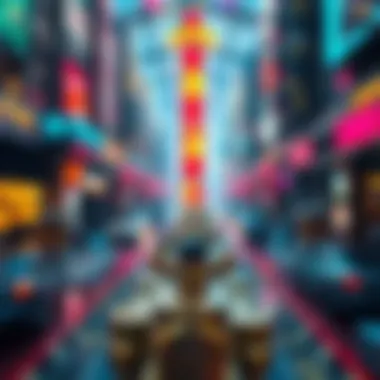

In the innovative realm of NFT art, the nuances of legal and ethical considerations form the backbone of its sustainability and credibility. As this digital landscape expands, these facets gain prominence; they not only influence how art is created and sold but also shape the dynamics between artists, collectors, and platforms. Understanding these issues is vital for anyone engaging in the market—be it traders, investors, or enthusiasts. Without clear guidelines, the integrity of the NFT market could falter, jeopardizing both its reputation and its financial viability.
Copyright Issues Surrounding NFT Art
Copyright law is essential in determining the ownership and distribution rights of digital art assets, especially in the context of NFTs. Unlike traditional art that might have definitive ownership, NFTs can muddle the waters. When a creator mints an NFT of their artwork, they might not automatically transfer copyright ownership to the buyer.
- Artistic Rights: The artist may retain the right to reproduce or display their work even after selling it as an NFT. This distinction is crucial for both creators and collectors, as misunderstanding these rights can lead to potential disputes.
- Licensing Agreements: Some artists may include licensing agreements that define what the buyer can or cannot do with the NFT. For example, purchasing an NFT does not necessarily mean one can use it commercially without the artist's consent.
- Geographical Variances: Different countries have varying laws regarding copyright, complicating the international sale and trade of NFT art. For instance, the rules in the United States contrast sharply with those in the European Union.
In summary, navigating copyright laws is like threading a needle in the dark. Ignorance can sow confusion and lead to costly missteps for both buyers and sellers alike.
Plagiarism and Authorship Dilemmas
As the NFT art scene blossoms, issues of plagiarism and authorship come to the fore. Unlike traditional artworks that have clear provenance, the digital nature of NFTs makes it easier for individuals to mimic or outright copy pieces and claim them as their own. This raises some uncomfortable questions:
- Attribution: Who gets the credit when digital art is reproduced? Is it the original creator, the one minting the NFT, or perhaps the platform hosting it? Clear attribution is necessary to uphold the credibility of the digital art world and protect the rights of artists.
- Challenges of Detection: Tracking ownership and originality in the digital environment can be akin to finding a needle in a haystack. While blockchain technology offers transparency, it cannot prevent individuals from misusing or appropriating work without proper permission.
- Platforms' Responsibility: Art platforms must walk a tightrope, balancing between encouraging creativity and protecting artists' rights. They often implement various measures, including content review protocols, but the effectiveness of these mechanisms can vary.
"In a digital age where copying can happen in an instant, the concept of originality faces unprecedented challenges."
Future of NFT Art Market
The future of the NFT art market holds immense significance, not just for artists and collectors, but also for investors, traders, and technology enthusiasts. As we look ahead, it’s apparent that this market is not merely a passing trend; it’s quickly becoming a pivotal part of the broader art ecosystem.
In the coming years, we expect to see increased integration of NFTs with traditional art markets. This could blur the lines between digital and physical art, creating new avenues for artists to showcase their work. With advancements in technology, the reach of digital platforms will likely expand, allowing a greater audience to participate in this fascinating arena. Moreover, understanding potential shifts in consumer behavior will be crucial for stakeholders in the progressively digitizing art landscape.
Potential Market Trends
There are several trends on the horizon that could shape the NFT art market.
- Enhanced User Experience: Blockchain technology will continue evolving, enhancing user experience for both creators and buyers. This could lead to smoother transactions and wider adoption.
- Sustainability Focus: As environmental concerns increase, we may see a shift towards more sustainable practices within the NFT market. Stakeholders might opt for platforms that minimize energy consumption.
- Diversity of Mediums: Expect more creators to explore various mediums and styles. From traditional art forms to experimental digital pieces, the art itself will diversify, allowing for rich cultural expressions. Some emerging artists may even utilize AI to push creative boundaries further.
- Lower Barriers to Entry: Platforms that support emerging artists will likely emerge, giving voice to those previously overlooked. This democratization could result in a broader array of available art and a lively market.
In essence, keeping an eye out for these evolving trends is crucial for anyone involved in the NFT space. The market is likely to grow more complex and rewarding.
Adoption and Integration with Traditional Art
As the lines between the digital and physical realms blur, the adoption of NFTs within traditional art institutions is becoming evident. Museums and galleries are beginning to explore how these digital assets can be incorporated into their collections.
- Exhibitions Featuring NFTs: Some galleries have started hosting exhibitions solely focused on NFT art. This allows audiences to experience these works in a physical space, bridging the gap between digital ownership and tactile appreciation.
- Collaborations with Traditional Artists: Traditional artists are beginning to explore NFTs as a new canvas. This collaboration between old and new brings fresh perspectives and engages a wider audience.
"The integration of NFTs into traditional art spaces can potentially reshape how we perceive value and ownership in art."
- Educational Initiatives: Institutions are offering programs on NFTs, educating both artists and collectors about the benefits and challenges of these digital assets. By fostering understanding, museums can help drive acceptance and encourage discussion around digital art.
Epilogue: Assessing the Impact of High-Value NFT Sales
The world of NFT art has become a spectacle of modern creativity. Understanding the impact of high-value NFT sales requires a closer inspection of how these transactions reverberate through the art world and beyond. These sales not only reflect the financial value placed on digital art but also signal shifts in how creativity, ownership, and commerce are perceived in a digital age.
Reflections on Art Valuation
When one looks at the most expensive NFT art sold, it's clear that there's more to these prices than mere numbers. These pieces become a mirror, reflecting societal values and cultural trends. Some key points to consider include:
- Market Sentiment: High-profile sales indicate a robust enthusiasm for digital assets. The competition among buyers often inflates prices beyond what traditional art markets might deem rational.
- Cultural Resonance: Works like Beeple's Everydays exemplify how art can encapsulate contemporary issues, making them desirable long after the initial sale.
- Investment Perception: Collectors are increasingly viewing NFTs not just as art but as assets. This shift is leading to an evolution in traditional valuation methods, making many rethink what art is worth.
Moreover, the challenges of valuing urban art versus conservative art projects amplify debates around who owns cultural narratives in the digital space. This contradiction pushes the art world into a new dialogue about meaning and origin, making the high prices of certain pieces a topic of intense scrutiny.
Final Thoughts on Digital Asset Investment
Investing in NFTs has undoubtedly raised eyebrows. Critics argue that the speculative nature of these sales is reminiscent of past market bubbles. However, there’s a nuanced perspective worth noting:
- Diversification: NFTs offer a fresh avenue for diversifying portfolios. Digital assets can hedge against traditional market volatilities, particularly in uncertain times.
- Accessibility: Unlike traditional artworks, NFTs democratize access to art investment. A younger generation of collectors enters the space, often utilizing avenues like crypto exchanges that weren't available previously.
- Community Engagement: Many NFT projects thrive on community involvement, enhancing the perceived value through collective ownership and investment. This brings a sense of belonging for many collectors, similar to membership in an exclusive club.
Ultimately, navigating the world of high-value NFT art requires an understanding of both its tumultuous history and its promising future. As the market continues to mature, wise investors and collectors must approach these digital assets with due diligence, keeping an eye on emerging trends while not losing sight of underlying principles of art and community.
"The NFT market's surging interest highlights the evolving relationship between art and technology, indicating that we are only scratching the surface of its potential."
For further reading on the nuances of art valuation and digital investments, you can explore resources such as Britannica and relevant discussions on platforms like Reddit that keep pace with developments in this field.









